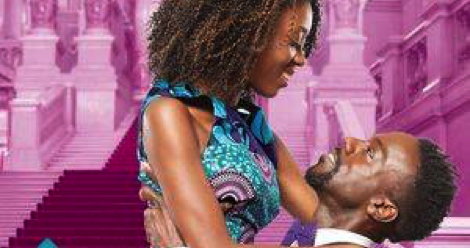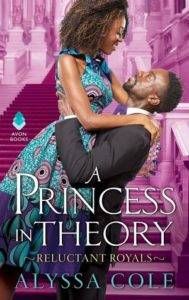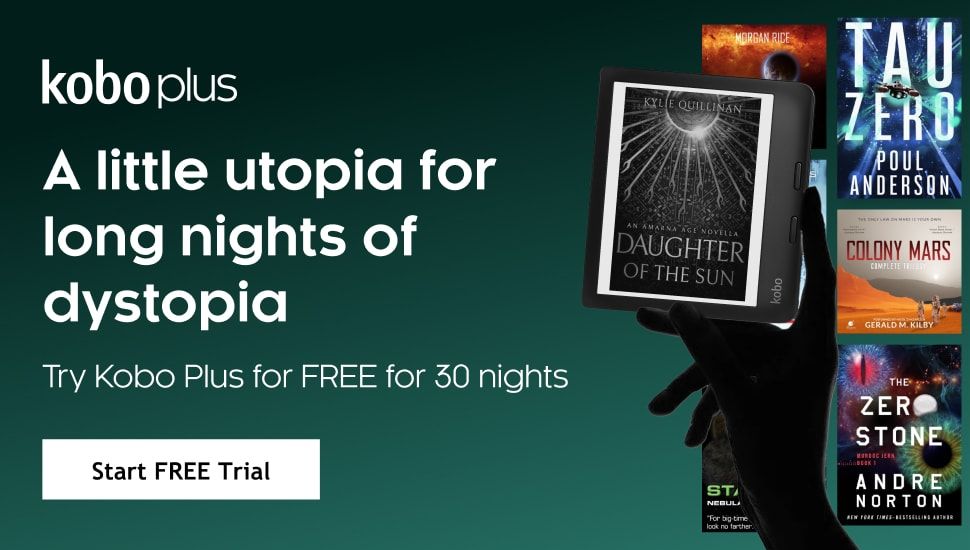
World-Building in Romance: A PRINCESS IN THEORY
I’ve been reading Alyssa Cole since I first stumbled across her Off The Grid series, and have been continually impressed by how broadly she writes. Historicals, near-future, paranormal…you name it, she’s written a book or short story in that genre. I’m delighted to report that her new contemporary romance, A Princess in Theory, is fantastic. It’s funny (one of my favorite scenes involves a fire extinguisher), it’s steamy (takeout and chill, anyone?), and it’s got me eagerly awaiting the next installment (A Duke By Default, July 2018). In fact, I would read a 17-book series with this cast—each supporting character is so well-drawn, and I need all my fictional faves to get their own HEA.
 One of my favorite things about A Princess in Theory is how much detail goes into showing the hero and heroine’s respective worlds. They come from very different places: Naledi is a poor graduate student in New York City and Thabiso is African royalty. Their lives collide when Thabiso decides to track down his missing betrothed, and Ledi discovers there’s a lot about her childhood that she doesn’t know.
One of my favorite things about A Princess in Theory is how much detail goes into showing the hero and heroine’s respective worlds. They come from very different places: Naledi is a poor graduate student in New York City and Thabiso is African royalty. Their lives collide when Thabiso decides to track down his missing betrothed, and Ledi discovers there’s a lot about her childhood that she doesn’t know.
While it might seem counterintuitive to talk about world-building in contemporary romance, it’s one of this book’s (many) strengths. Alyssa kindly agreed to answer my questions about her process.
Historical romances have a habit of making up titled individuals—Regencies in particular are overflowing with fictional dukedoms. What are the considerations for writing royalty in a contemporary romance? Why did you decide to create a fictional African country, rather than use a real one?
Well, when I started researching, I realized that there were way more modern royals and aristocracy than I had imagined! So these titles that we generally associate with historicals, and in some cases the power that comes with them, still remain, but we’re in a time where monarchies aren’t always seen as these forms of absolute power and the aristocracy are not as rich or powerful as a tech entrepreneur. Or if a monarchy does have total power, they don’t always wield it in a way that isn’t somewhat harmful to their people (which can be said of pretty much all extant forms of government).
Modern royalty are often treated similarly to Hollywood stars; they’re celebrities that have a prestige that really holds a specific fascination for the public in a way actors don’t—most of us grew up reading the same fairy tales and watching the same Disney movies. But they’re born or marry into this life, and have a different kind of political capital and power. I tried to think of how the internet, social media, globalization, and current events would affect a modern royal, and how, to a certain extent, it’s a job, and one you can’t really opt out of. I guess I was trying to combine the lavish fantasy aspect of royalty romance and the fact that it seems like it probably sucks being in the spotlight so much and having unimaginable responsibility.
As for creating Thesolo instead of setting the story in a real country: when I first had the idea for A Princess in Theory, I was imagining writing a short fun category romance type novel, but heavy on the romantic comedy. The book did not turn out to be short, lol, but I did retain the “fictional country” aspect found in many category romances. In each book, I wanted to make a fictional location that could be in our reality, but serves as an additional layer of fantasy. In A Duke by Default, the second book in the series, the story takes place in Scotland, in a neighborhood that doesn’t exist in reality but plays an important role. Creating fictional countries is fun, and it helps avoid appropriating or misconstruing someone else’s homeland.
Also, when you think of The Princess Diaries or Coming to America, which both influenced this book to some extent, you have Genovia and Zamunda, respectively. Thesolo is joining the prestigious ranks of fake rom-com kingdoms!
Thesolo felt very real to me, thanks to all the details you included. The goddess and her priestesses, the betrothal ceremony, the cloak blankets, the tours that Naledi takes; it felt meticulously planned. How did you go about creating Thesolo and its traditions and geography?
Many aspects of Thesoloian culture are based in the culture of Lesotho, which is a real African kingdom; there are also influences from other African cultures. The cloaks, for example, and some of the food, names, and aspects of the language—Lesotho is the foundation, even of the fictional country’s name! I didn’t want to use Lesotho’s culture but completely erase it from the book.
Other aspects were just me letting my imagination have at it. The goddess Ingoka and her priestesses, for example. I wanted Thesolo to be modern and somewhat secular, but to have an actual religious system and deity which the people believe in at varying levels, including Prince Thabiso. I wanted it to be based in a feminine power, and to be a religion that guides but doesn’t harshly judge or harm its adherents, though other problems do arise. I incorporated aspects of traditional dance and call/response singing into some of the ceremonies. I wanted it to feel real, because it had to be real enough to affect the heroine Naledi, who’s pretty cynical, and the reader has to believe it in order for that to happen.
When showing the country via Naledi’s perspective, I tried to pay attention to small details that would convey that this was a place that was steeped in tradition but also invested in technological advances that would better the lives of its people. It’s no Wakanda, but because they’re small and wealthy, they are able to do test runs of, for example, environmentally friendly technology that would be difficult to roll out in a large country.
The geography is also based on Lesotho. It’s this beautiful mountainous area—I want to visit so badly after looking at pictures while researching!—and I tried to incorporate these amazing mountains and waterfalls and valleys into the descriptions of Thesolo.
It felt to me like you were busting “Africa” stereotypes intentionally. For example, the hero and heroine get caught in a snowstorm; not a common trope in stories set on the African continent! In addition, Thesolo has advanced technology and high standards of living. Talk to me about your thought process.
I was definitely trying to on some level; I was not born in an African country, but I think anyone paying attention can see how only certain narratives have been allowed to them in the mainstream. I thought of Chimamanda Ngozi Adichie’s The Danger of a Single Story, about how she was rich in her country, but her American roommate in college assumed she must have lived in a mud hut because Americans were basically only presented with the charity infomercial version of Africa. So some aspects of the world-building came from trying to add layers to that single story, debunking the idea that there is any one way that people on this huge continent would have to live or act. Yes, Thesolo is a fictional country, but fiction can expose readers to other narratives outside of the flattened one presented by the media or history books.
I also wanted Thesolo to be a place that existed outside of colonialism. I do touch on external friction with governments and business entities, but I wanted Thesolo to be a country that never had to deal with invasion by Europeans and everything that came with that. On one level, this was because I wanted the story to be lighter—this is a rom-com!—but this also adds to the pressure on Prince Thabiso to maintain Thesolo’s autonomy. Plus I wanted to explore, without making the book explicitly about it, how destructive colonization was by showing what was possible if it had never come to be. I’m certainly not the first person to think of this, though! I wrote the first draft of this before Coates’s run of Black Panther, but Wakanda—and even Zamunda (from Coming to America)—are also in this vein (there was that thing with the Namor and Wakanda, but I didn’t read that run yet and I’m not gonna get into comics stuff that I am not SUPER WELL-VERSED in because we all know how that goes, don’t @ me).
Speaking of writing royalty generally, you have me believing that Gate R at LaGuardia is real (although a Google search could not confirm). How does one go about learning what the day-to-day life of a prince looks like?
I cannot confirm or deny the existence of Gate R, but I can say that LAX recently opened a “celebrity only” gate so apparently it’s not that far fetched! I mean, have you ever seen the Queen photographed at the arrivals gate? Lol. To create Thabiso’s daily schedule, I used my knowledge of celebrities gleaned from years of tabloids, looked into scheduled events for royalty (i.e., where they were having photo opps), and what I knew about political summits, United Nations meetings, etc., in general, and threw in a dash of business because politics is often just business when you get down to it.
Of course, Thabiso isn’t the only one who inhabits a very specific and interesting world. I loved seeing Ledi’s point of view—her passion for her studies was so clear, and her epidemiology metaphors popped up all over the place! What was the research like writing her?
Ledi was really fun for me to write because I worked at a science journal for many (many, many) years and have always thought about the researchers submitting their papers to us, the effort of years of hard work and dedication. At work, I spent most days reading and editing research papers, and when I had the idea for Ledi I was like, “Finally! I can use these years of accumulated knowledge!” I’d written a researcher before, but he was an astronomer and it was after an apocalypse, so I didn’t get to explore his work in the same way. (I also started getting a lot of spam mail at my work email, which is partially what sparked this idea!)
Also, I had friends who were researchers and none of them were the “uptight hapless super nerd” stereotype often forced on women in STEM in pop culture ([1] see the danger of a single story; [2] if you’ve read other books of mine, you know that uptight hapless super nerds are my jam, so that wasn’t meant as a bad thing, just an incorrect generalization). I just really enjoy science listening to podcasts (my favorite podcasts for practicing French are La méthode scientifique and La tête au carré), reading books and articles, seeing random tidbits on social media, etc. So I already had a lot of random scientific minutiae stored up, and then I got to spend time researching even more stuff that I found interesting (and wasn’t depressing, like my Civil War research). Most of it didn’t make it into the book of course, but I’m sure it will be useful someday!
And I wanted to show how Ledi had to specifically navigate her career as a Black woman in STEM. I want everyone to connect with her, but I wanted women who have to deal with being mistaken for the cleaning woman, being talked over or doubted, or told they have an attitude when they make a simple assertion, to feel seen too.
Last but not least: In my internal movie, Thabiso looks like Chadwick Boseman and Ledi looks like Gabrielle Union with curls. What does your mental casting look like?
Ooooo, I love this casting! When I’m writing, I generally don’t do mental casting; that usually happens after the book is finished for me. For me, Thabiso is Kofi Siriboe from Queen Sugar. The first time I saw a picture of him glide by on the timeline I was like, “Heeeeey Thabiso!” For Naledi, I love Yetide Badaki from American Gods, but with a curly do.
















